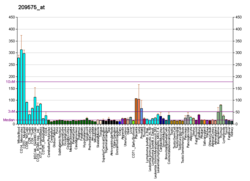From Wikipedia, the free encyclopedia
Protein-coding gene in the species Homo sapiens
Interleukin 10 receptor, beta subunit is a subunit for the interleukin-10 receptor . IL10RB is its human gene .[ 5]
IL10RB has also been designated CDw210b (cluster of differentiation w210b).
The protein encoded by this gene belongs to the cytokine receptor family. It is an accessory chain essential for the active interleukin 10 receptor complex. Coexpression of this and IL10RA proteins has been shown to be required for IL10-induced signal transduction. This gene and three other interferon receptor genes, IFNAR2 IFNAR1 IFNGR2 class II cytokine receptor gene cluster located in a small region on chromosome 21.[ 5]
References
Further reading
Lutfalla G, McInnis MG, Antonarakis SE, Uzé G (1995). "Structure of the human CRFB4 gene: comparison with its IFNAR neighbor". J. Mol. Evol . 41 (3): 338–44. doi :10.1007/BF01215180 . PMID 7563119 . S2CID 38574595 . Lutfalla G, Gardiner K, Uzé G (1993). "A new member of the cytokine receptor gene family maps on chromosome 21 at less than 35 kb from IFNAR". Genomics . 16 (2): 366–73. doi :10.1006/geno.1993.1199 . PMID 8314576 . Gibbs VC, Pennica D (1997). "CRF2-4: isolation of cDNA clones encoding the human and mouse proteins". Gene . 186 (1): 97–101. doi :10.1016/S0378-1119(96)00690-7 . PMID 9047351 . Kotenko SV, Krause CD, Izotova LS, et al. (1997). "Identification and functional characterization of a second chain of the interleukin-10 receptor complex" . EMBO J . 16 (19): 5894–903. doi :10.1093/emboj/16.19.5894 . PMC 1170220 PMID 9312047 . Spencer SD, Di Marco F, Hooley J, et al. (1998). "The orphan receptor CRF2-4 is an essential subunit of the interleukin 10 receptor" . J. Exp. Med . 187 (4): 571–8. doi :10.1084/jem.187.4.571 . PMC 2212143 PMID 9463407 . Reboul J, Gardiner K, Monneron D, et al. (1999). "Comparative genomic analysis of the interferon/interleukin-10 receptor gene cluster" . Genome Res . 9 (3): 242–50. doi :10.1101/gr.9.3.242 . PMC 310731 PMID 10077530 . Hattori M, Fujiyama A, Taylor TD, et al. (2000). "The DNA sequence of human chromosome 21" . Nature . 405 (6784): 311–9. Bibcode :2000Natur.405..311H . doi :10.1038/35012518 PMID 10830953 . Xie MH, Aggarwal S, Ho WH, et al. (2000). "Interleukin (IL)-22, a novel human cytokine that signals through the interferon receptor-related proteins CRF2-4 and IL-22R" . J. Biol. Chem . 275 (40): 31335–9. doi :10.1074/jbc.M005304200 PMID 10875937 . Dumoutier L, Van Roost E, Colau D, Renauld JC (2000). "Human interleukin-10-related T cell-derived inducible factor: molecular cloning and functional characterization as an hepatocyte-stimulating factor" . Proc. Natl. Acad. Sci. U.S.A . 97 (18): 10144–9. Bibcode :2000PNAS...9710144D . doi :10.1073/pnas.170291697 PMC 27764 PMID 10954742 . Lewis K, Li C, Perrin MH, et al. (2001). "Identification of urocortin III, an additional member of the corticotropin-releasing factor (CRF) family with high affinity for the CRF2 receptor" . Proc. Natl. Acad. Sci. U.S.A . 98 (13): 7570–5. Bibcode :2001PNAS...98.7570L . doi :10.1073/pnas.121165198 PMC 34709 PMID 11416224 . Hollborn M, Kohen L, Wiedemann P, Enzmann V (2001). "The influence of pro-inflammatory cytokines on human retinal pigment epithelium cell receptors". Graefes Arch. Clin. Exp. Ophthalmol . 239 (4): 294–301. doi :10.1007/s004170100263 . PMID 11450494 . S2CID 676836 . Josephson K, Logsdon NJ, Walter MR (2001). "Crystal structure of the IL-10/IL-10R1 complex reveals a shared receptor binding site" . Immunity . 15 (1): 35–46. doi :10.1016/S1074-7613(01)00169-8 PMID 11485736 . Sheppard P, Kindsvogel W, Xu W, et al. (2003). "IL-28, IL-29 and their class II cytokine receptor IL-28R". Nat. Immunol . 4 (1): 63–8. doi :10.1038/ni873 . PMID 12469119 . S2CID 35764259 . Strausberg RL, Feingold EA, Grouse LH, et al. (2003). "Generation and initial analysis of more than 15,000 full-length human and mouse cDNA sequences" . Proc. Natl. Acad. Sci. U.S.A . 99 (26): 16899–903. Bibcode :2002PNAS...9916899M . doi :10.1073/pnas.242603899 PMC 139241 PMID 12477932 . Kotenko SV, Gallagher G, Baurin VV, et al. (2003). "IFN-lambdas mediate antiviral protection through a distinct class II cytokine receptor complex". Nat. Immunol . 4 (1): 69–77. doi :10.1038/ni875 . PMID 12483210 . S2CID 2734534 . Hör S, Pirzer H, Dumoutier L, et al. (2004). "The T-cell lymphokine interleukin-26 targets epithelial cells through the interleukin-20 receptor 1 and interleukin-10 receptor 2 chains" . J. Biol. Chem . 279 (32): 33343–51. doi :10.1074/jbc.M405000200 PMID 15178681 . Zhang Z, Henzel WJ (2005). "Signal peptide prediction based on analysis of experimentally verified cleavage sites" . Protein Sci . 13 (10): 2819–24. doi :10.1110/ps.04682504 . PMC 2286551 PMID 15340161 . Gerhard DS, Wagner L, Feingold EA, et al. (2004). "The status, quality, and expansion of the NIH full-length cDNA project: the Mammalian Gene Collection (MGC)" . Genome Res . 14 (10B): 2121–7. doi :10.1101/gr.2596504 . PMC 528928 PMID 15489334 . Pletnev S, Magracheva E, Wlodawer A, Zdanov A (2006). "A model of the ternary complex of interleukin-10 with its soluble receptors" . BMC Struct. Biol . 5 : 10. doi :10.1186/1472-6807-5-10 . PMC 1192808 PMID 15985167 . {{cite journal }}: CS1 maint: unflagged free DOI (link )Kimura K, Wakamatsu A, Suzuki Y, et al. (2006). "Diversification of transcriptional modulation: large-scale identification and characterization of putative alternative promoters of human genes" . Genome Res . 16 (1): 55–65. doi :10.1101/gr.4039406 . PMC 1356129 PMID 16344560 .
This article incorporates text from the United States National Library of Medicine , which is in the public domain .
1–50 51–100 101–150 151–200 201–250 251–300 301–350





